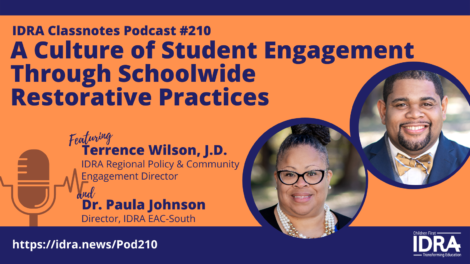
A Culture of Student Engagement Through Schoolwide Restorative Practices – Podcast Episode 210 | Classnotes Podcast 210
Podcast: Play in new window | Download
 Classnotes Podcast (April 26, 2021). Often, people talk about restorative practice as an approach to student discipline. It is true that restorative practices include a reactive component designed to restore relationships by repairing harm. But that is not the best place to start implementing restorative practices in a school.
Classnotes Podcast (April 26, 2021). Often, people talk about restorative practice as an approach to student discipline. It is true that restorative practices include a reactive component designed to restore relationships by repairing harm. But that is not the best place to start implementing restorative practices in a school.
In this episode, Dr. Paula Johnson, director, IDRA EAC-South, and Terrence Wilson, J.D., IDRA regional policy and community engagement director, describe how restorative practice is proactive in developing community by building relationships and positive school climates that value all students. They describe a range of ways educators can start using restorative practices to create an environment where students want to engage.
Send comments to podcast@idra.org.
Sign up to receive free e-mail notices when new episodes are available.
Show length: 23:31 min.
Resources
Restorative Practices Campus Team Training and Coaching Support Services by IDRA
Restorative Practices – Informal and Formal Processes for Addressing Behavior, by Paula N. Johnson, Ph.D., April 8, 2019
How Using Restorative Practices Can Prevent Exclusionary Discipline Issues, by Kristin Grayson, Ph.D., & Paula Johnson, M.A., January 31, 2018
Your feedback
We welcome your comments and questions to the podcast. Send an e-mail to podcast@idra.org.
Listen to every episode!
To ensure you don’t miss a single episode of IDRA Classnotes, subscribe to the podcast in iTunes, (download iTunes free if you don’t have it) or sign up to receive an e-mail alert as soon as a new show is published.



